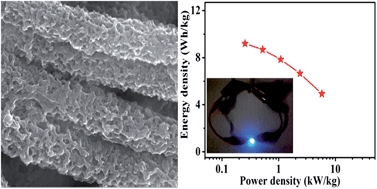Flexible solid-state supercapacitors based on freestanding nitrogen-doped porous carbon nanofibers derived from electrospun polyacrylonitrile@polyaniline nanofibers†
Abstract
Freestanding nitrogen-doped porous carbon nanofibers (NPCNFs) are prepared by carbonizing the nitrogen-enriched porous binary polymer precursors of electrospun polyacrylonitrile/polyaniline core–shell composite nanofibers at an appropriate temperature. The obtained freestanding NPCNFs with the advantages of a suitable nitrogen content, hierarchical porosity, large specific surface areas, and good conductivity are very promising to achieve desirable electrochemical performance. As expected, the NPCNFs as electrode materials demonstrate a high specific capacitance of 335 F g−1 at a current density of 0.5 A g−1 and high rate capability with a capacitance retention of 175 F g−1 at 32 A g−1 in a three-electrode configuration test. Particularly, the as-fabricated flexible solid-state supercapacitor based on the freestanding NPCNFs delivers a maximum energy density of 9.2 W h kg−1 at 0.25 kW kg−1 and also presents good cycling stability with 86% capacitance retention after 10 000 cycles at a current density of 5 A g−1. Therefore, the freestanding NPCNFs as electrode materials for flexible solid-state supercapacitors might have potential applications in portable and flexible electronics.


 Please wait while we load your content...
Please wait while we load your content...